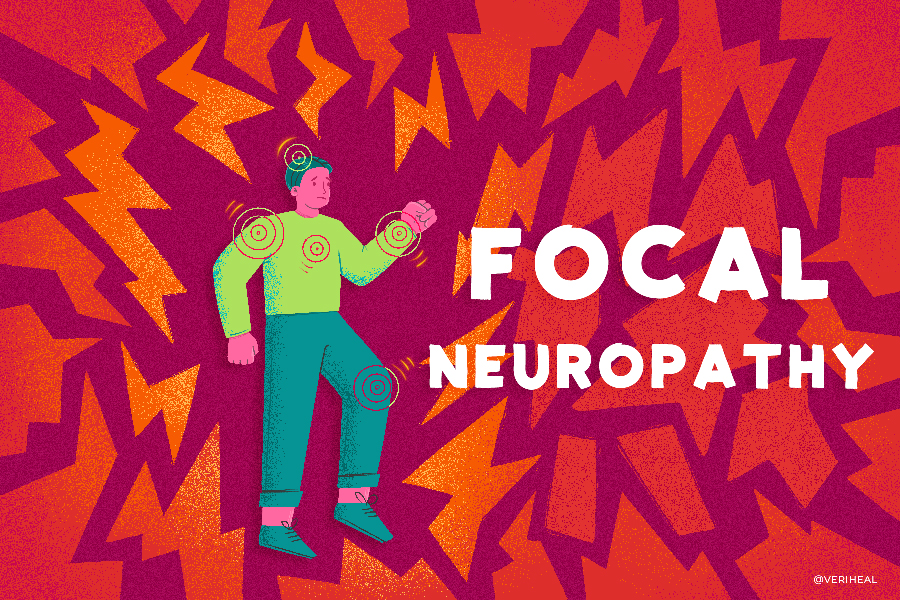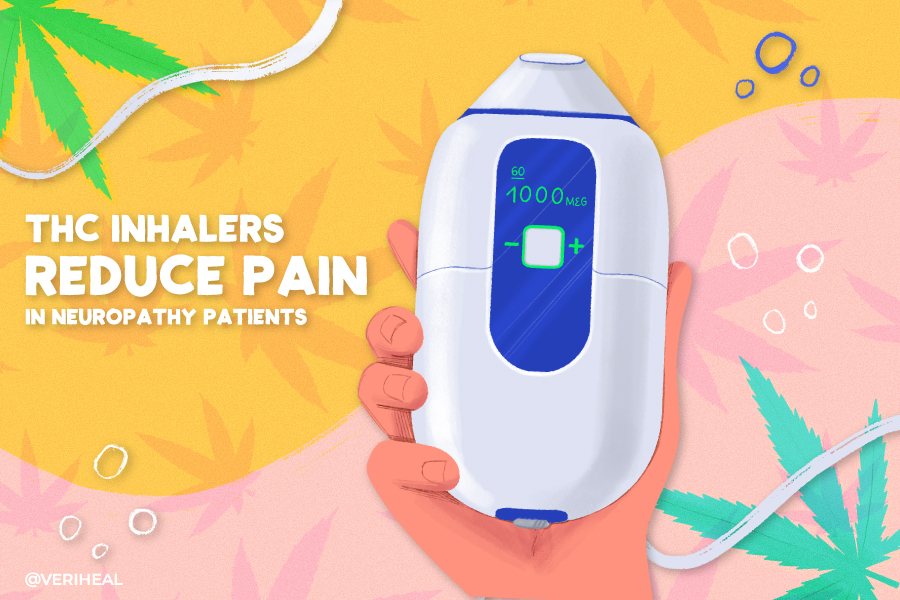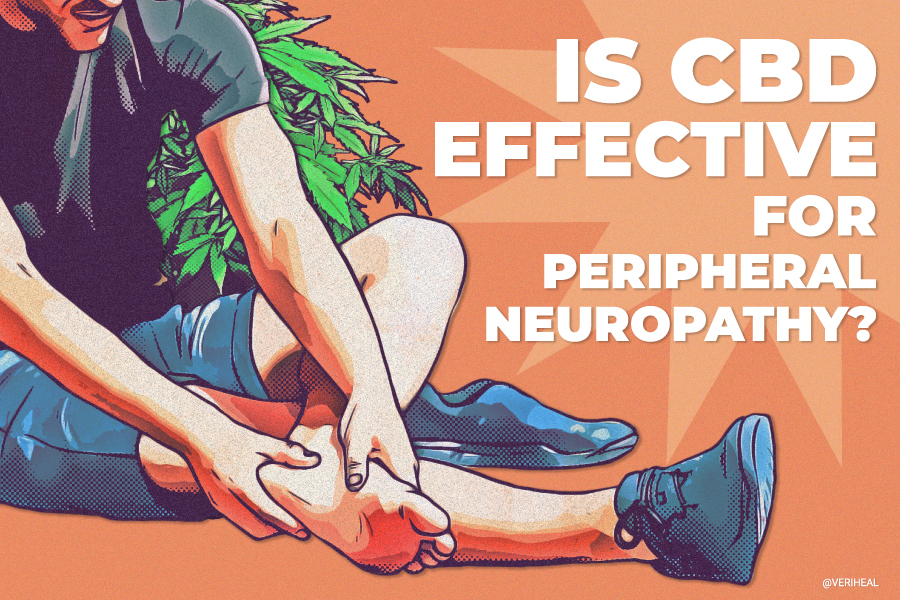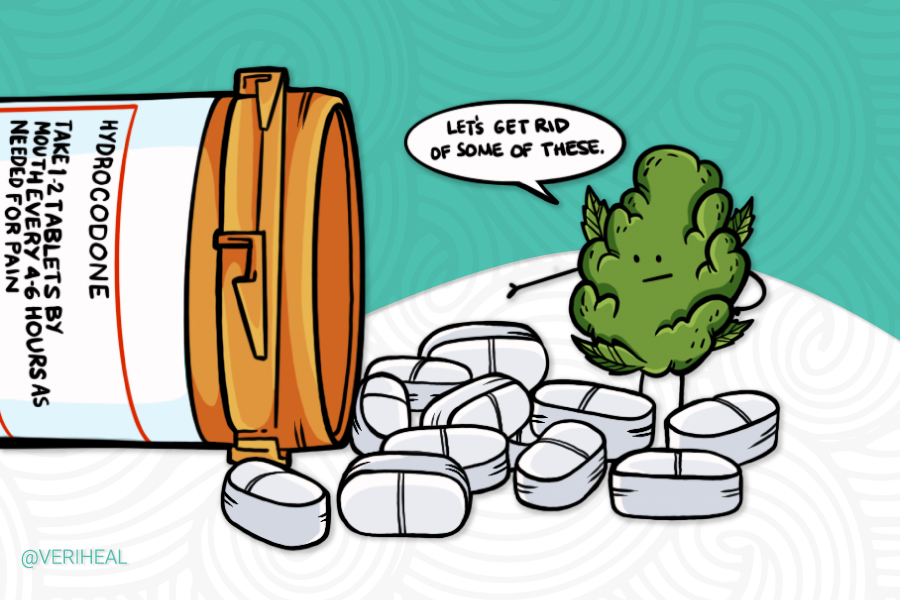Focal Neuropathy
- Focal Neuropathy: Signs, Symptoms and Types
- Focal Neuropathy Treatment: Can Cannabinoids Provide Relief?
- The Role of the Endocannabinoid System in Treating Focal Neuropathy
- What are the Best Preparations of Cannabis for Focal Neuropathy
- Talk to Your Doctor About Medical Cannabis
- Complementary Treatments Worth Discussing With Your Doctor
Approximately 25% to 30% of Americans experience neuropathy at some point in their lifetime. Neuropathy refers to nerve malfunctioning or disease resulting in pain or abnormal sensations (13). Of all the different types of neuropathy, focal neuropathy is one of the most common.
The word ‘focal’ refers to the single site of peripheral nerve injury/disease. People of all age groups can be affected by focal neuropathy, but people with diabetes and older people face a higher risk. The resulting pain can affect a single body area, such as a foot, wrist, ankle, or a particular region of the head or trunk.
Even though the symptoms of focal neuropathies tend to dissolve within 6-8 weeks, some people will continue to experience them chronically if they have diabetes. The sudden onset of this medical condition can also leave you feeling uncomfortable and lacking motivation and sleep to enjoy daily life as you usually would.
Since certain types of focal neuropathies can get worse as time progresses, finding appropriate treatment options should be at the top of your priority list. Fortunately, it is possible to treat, but not usually cure, neuropathy. When a case of neuropathy is incurable due to a chronic underlying condition, your doctor will likely prescribe you medicine(s) to manage the symptoms and prevent further nerve damage from occurring by treating the underlying disease.
Globally advancing cannabis legalization means more doctors and scientists are exploring the possibility of implementing medical marijuana into focal neuropathy treatment regimens. Considering the potent powerhouse plant’s natural capability to relieve pain and inflammation, as outlined in this systematic review and meta-analysis article, cannabis’s growing acceptance is not surprising (15).
Focal Neuropathy: Signs, Symptoms and Types
Before considering cannabis as a treatment option for focal neuropathy, it’s essential to brush up on your knowledge of focal neuropathy. This medical condition occurs when the sensory nerves — responsible for transmitting vital signals from your five senses (hearing, sight, smell, taste, and touch) through your spinal cord and into your brain — become damaged.
It’s not just the sensory nerves that might become damaged in cases of focal neuropathy but also the motor and the autonomic nerves. The motor nerves send messages in the opposite direction of the sensory nerves. The autonomic nerves maintain movement, proprioception, proper breathing, blood pressure, bladder control, digestion, heart rate, sexual arousal, and sweating.
Someone diagnosed with focal neuropathy will endure injury and subsequent pain, weakness, or numbness in one or a handful of nerves in a specific location.
Compression issues or trauma may trigger the onset of focal neuropathic pain. Focal nerve entrapments and neurodegenerative conditions like diabetes and HIV can cause patients to experience acute or chronic pain. The entrapment or nerve damage may occur in the areas and symptoms as follows:
- Carpal tunnel syndrome (CTS) (median nerve)
- Cubital tunnel syndrome (ulnar nerve)
- Obturator nerve of the groin area
- Suprascapular nerve
- Thoracic outlet syndrome (TOS) (particularly the lower trunk)
- Tarsal tunnel syndrome (posterior tibial nerve)
- Interdigit nerves (particularly between the 3rd and 4th toes, known as Morton’s Neuroma)
- Peroneal Entrapment
- Posterior interosseous nerve (PIN)
- Vision trouble
- Facial paralysis (Bell’s palsy)
- Pain on one side of the torso, thigh, foot, or leg
Should your doctor diagnose you with focal neuropathy involving nerve entrapment, your symptoms will likely appear quickly without warning and gradually diminish over a few months or weeks. Other focal neuropathy from chronic conditions like diabetes, HIV/AIDS, and stroke will be chronic and difficult to treat.
Symptoms are dependent upon the cause and type of nerve being affected. The most commonly reported symptoms of focal neuropathy include stabbing pain, numbness and tingling, muscle weakness, paralysis, cramps, and changes in sensation in the following areas of the body:
- hand
- leg
- foot
- torso
A doctor may diagnose you with cranial focal neuropathy if you experience double vision, facial paralysis (Bell’s palsy), eye ache, or visual focus problems. Cranial neuropathies affect nerves in the head (16).
Focal Neuropathy Causes and Complications
Focal neuropathy may be (but is not always) inherited. Vascular disorders that restrict blood flow to the arms and legs might increase the chances of a person developing focal neuropathies. Not only can the nerves become damaged but also the vessels that amplify your nerves.
It is not uncommon for patients to have abnormal vitamin levels or struggle with alcoholism. Furthermore, poor diets and underlying medical conditions cause your blood glucose levels to elevate, thus resulting in high blood pressure – a primary cause of focal neuropathy-related nerve damage.
Another potential cause of focal neuropathy is high levels of sugars and fats like triglycerides in the blood – something that commonly occurs in patients with diabetes. Diabetic neuropathy occurs in approximately 50% of diabetes patients (6).
Neuropathic pain may surface if you have an autoimmune disorder, infection, or health condition(s) like tumors, liver problems, and kidney disorders. Doctors have also pinpointed HIV medications and certain types of anti-seizure medications as causes of neuropathy.
Focal Neuropathy Treatment: Can Cannabinoids Provide Relief?
When a nerve becomes trapped (entrapment), a doctor may advise you to wear a brace or splint to stabilize the area and relieve nerve pressure, treat the underlying chronic condition, use an anti-inflammatory, consume or topically apply medicines used to ease the side effects of peripheral neuropathy pain, or undergo surgery as a last resort (17).
Conversely, for focal neuropathies that don’t involve entrapment or a chronic condition, recovery usually takes a couple of weeks or months (even without treatment.) An emerging treatment option that could present promising results is cannabis.
Small clinical studies hypothesize that the cannabis plant offers a whole host of benefits for cases of peripheral neuropathy, such as chronic neuropathic pain relief, improved sleep, and better overall function (10).
In 2009, a report titled “Cannabinoids as pharmacotherapies for neuropathic pain” noted how clinical studies largely attest that cannabis-derived cannabinoids can benefit neuropathic pain patients (14).
Moreover, since focal nerve problems can cause swelling, pain, tingling, weakness, and numbness in various parts of the body, cannabis’ potent analgesic and anti-inflammatory properties could be of great use to patients (12).
A 2021 systematic review and meta-analysis, including 17 randomized controlled trials, showed that low-dose cannabis offered short-term relief from neuropathic pain in patients resistant to alternative treatment methods (20).
The authors described that “…THC and THC/CBD interventions provided a significant improvement in pain intensity and were more likely to provide a 30% reduction in pain.” However, they also noted that the studies are still of moderate-low quality and lacking in the long term.
Another prospective study published by PubMed revealed that the use of cannabis might contribute to improved quality of life and serve as valuable pain management and effective opioid-reduction tool (5). All this while improving functionality and social and emotional disability. This study was limited because it was noncontrolled and open-label, meaning the patients were all taking cannabis and knew it.
Many cannabis-based products have also been evaluated for suitability as a treatment for neuropathic pain, such as this review featured in the Cochrane Database of Systematic Reviews (11). Unfortunately, in this review, the authors noted that “There is a lack of good evidence that any cannabis-derived product works for any chronic neuropathic pain” and were worried about the potential side effects of cannabis.
Previous systematic reviews like those have found conflicting research since the studies aren’t long enough or high-quality. Nevertheless, a more recent 2022 review of long-term neuropathy studies states that cannabis-based medicines had positive effects on multiple symptoms for some chronic neuropathy patients and were generally well tolerated and safe (2). They also acknowledge that “The European Pain Federation (EFIC) stated that CbMs can be used as third-line therapies for chronic neuropathic pain and as an individual therapeutic trial in all other chronic pain conditions if established treatment options have failed.”
By contrast, a 2020 clinical study examining the effectiveness of topical CBD oil in symptomatic relief of peripheral neuropathy of the lower extremities positively reported that “Our findings demonstrate that the transdermal application of CBD oil can achieve significant improvement in pain and other disturbing sensations in patients with peripheral neuropathy (21).”
Cannabinoids block peripheral nerve and inflammatory pain signals to the brain, even when administered in low concentrations (8).
Additionally, the anxiolytic, analgesic and sleep-promoting properties of cannabis’ non-psychotropic compound CBD could help patients to manage the mentally-impairing effects of focal neuropathy, such as depression, loneliness, and frustration (3).
The Role of the Endocannabinoid System in Treating Focal Neuropathy
The endocannabinoid system (ECS) strongly connects many of the body’s systems. Since the brain has an abundance of endocannabinoid receptors, it goes without saying that the cannabis plant could bolster overall health.
Endocannabinoid receptors bind to endocannabinoids, the cannabinoids produced by the human body, or phytocannabinoids, which the cannabis plant itself has. Dosing up on cannabis’ active cannabinoids is a surefire way to directly and indirectly influence the ECS.
It’s also worth considering that you can potentially stimulate your ECS to help stabilize blood sugar (1). This relates to focal neuropathy because diabetes is a leading cause of neuropathy. Researchers know that over time, unmanaged high blood sugar negatively impacts blood vessels and nerves and disrupts their ability to send signals, resulting in diabetic neuropathy (9).
What are the Best Preparations of Cannabis for Focal Neuropathy?
So diverse is medical marijuana for neuropathy in terms of consumption methods that this natural substance is being adopted on a wide scale by patients with the condition.
There are several different medicinal cannabis preparations, including edibles, powder cannabis/dissolvable cannabis, pills, capsules, tablets, tinctures, and vapes.
Research on cannabis and pain suggests starting at modest levels and carefully titrating over at least two weeks, with a recommended maximum of ~30 mg of edible cannabis per day (7). Topical CBD has also been effective in a 2020 small clinical neuropathy study (21).
If you want to enjoy fast relief from the nerve pain caused by focal neuropathy for 90 minutes or more, opt for either of the following cannabis preparations:
- Inhalable cannabis preparations that can be vaped for superb and fast-acting cannabinoid bioavailability
- Tinctures that release the effects of cannabinoids via bloodstream absorption within 15-30 minutes
- Water-soluble cannabinoid powder, which gets to work with your body’s cannabinoid receptors within 20 minutes
The cannabidiol (CBD) and delta-9 tetrahydrocannabinol (THC) contained in topicals or transdermal patches also get absorbed by the bloodstream, whereas the gut processes edibles. While edibles might take 30 minutes-two hours to release their effects, they can be felt over a 5-8 hour window.
Capsules, pills, and tablets made using gelatin or starch will take approximately 30 minutes to dissolve after being ingested and may provide symptomatic relief for five hours or more.
Talk to Your Doctor About Medical Cannabis
To better understand what is causing your focal neuropathy and how you can effectively manage your symptoms, it’s worth arranging a meeting with your doctor. They can conduct a medical examination and browse your medical history before providing a diagnosis and treatment plan.
Often, doctors will do a physical exam and conduct lab tests to check for common causes. If still unclear, they may include nerve conduction studies and electromyography (EMG) to assess the speed at which electrical signals move through different body parts (19, 18). Doctors will also use special equipment to watch how your muscles respond to nerve activity.
Once you’ve received a diagnosis, take a moment to open up with your doctor about your interest in trying medical cannabis. You should be prepared to talk about any medications you are currently taking. Medical cannabis should not be considered a substitute for other doctor-prescribed medications or approved treatments.
Complementary Treatments Worth Discussing with Your Doctor
Regardless of whether you are doing physical therapy, bracing, or medicating with conventional doctor-prescribed medication or not, medical cannabis could help you control the discomfort caused by focal neuropathy. Nonetheless, medicinal-grade cannabis should be considered a complementary treatment and not an alternative to conventional health care.
Popular complementary therapy methods for focal neuropathy include biofeedback, guided imagery, dietary supplements, and guided healing meditation. Your doctor might suggest you try complementary therapies like acupuncture and megavitamins (4).
Whatever route you go down when treating focal neuropathy, such as pain-relieving topical cannabis, you must continue taking any medication(s) and treatments prescribed by your doctor.
Note: The content on this page is for informational purposes only and is not intended to be professional medical advice. Do not attempt to self-diagnose or prescribe treatment based on the information provided. Always consult a physician before making any decision on the treatment of a medical condition.
- Abioye, A., Ayodele, O., Marinkovic, A., Patidar, R., Akinwekomi, A., & Sanyaolu, A. (2020). Δ9-Tetrahydrocannabivarin (THCV): A commentary on potential therapeutic benefit for the management of obesity and diabetes. Journal of Cannabis Research, 2(1). https://jcannabisresearch.biomedcentral.com/articles/10.1186/s42238-020-0016-7
- Bialas, P., Fitzcharles, M. A., Klose, P., & Häuser, W. (2022). Long‐term observational studies with cannabis based medicines for chronic non‐cancer pain: A systematic review and meta analysis of effectiveness and safety. European Journal of Pain, 26(6), 1221–1233. https://onlinelibrary.wiley.com/doi/10.1002/ejp.1957
- Blessing, E. M., Steenkamp, M. M., Manzanares, J., & Marmar, C. R. (2015). Cannabidiol as a potential treatment for anxiety disorders. Neurotherapeutics, 12(4), 825–836. https://link.springer.com/article/10.1007/s13311-015-0387-1
- Brunelli, B., & Gorson, K. C. (2004). The use of complementary and alternative medicines by patients with peripheral neuropathy. Journal of the Neurological Sciences, 218(1-2), 59–66. https://pubmed.ncbi.nlm.nih.gov/14759634/
- Haroutounian, S., Ratz, Y., Ginosar, Y., Furmanov, K., Saifi, F., Meidan, R., & Davidson, E. (2016). The effect of medicinal cannabis on pain and quality-of-life outcomes in chronic pain. The Clinical Journal of Pain, 32(12), 1036–1043. https://pubmed.ncbi.nlm.nih.gov/26889611/
- Hicks, C. W., & Selvin, E. (2019). Epidemiology of peripheral neuropathy and lower extremity disease in diabetes. Current Diabetes Reports, 19(10). https://www.ncbi.nlm.nih.gov/pmc/articles/PMC6755905/#:~:text=Purpose%20of%20Review%3A,ulcers%2C%20and%20lower%20limb%20amputation
- MacCallum, C. A., & Russo, E. B. (2018). Practical considerations in Medical Cannabis Administration and dosing. European Journal of Internal Medicine, 49, 12–19. https://www.ejinme.com/article/S0953-6205(18)30004-9/fulltext
- Mack A, Joy J. Marijuana as Medicine? The Science Beyond the Controversy. Washington (DC): National Academies Press (US); 2000. 4, MARIJUANA AND PAIN. Available from: https://www.ncbi.nlm.nih.gov/books/NBK224384/
- Mayo Foundation for Medical Education and Research. (2022, April 29). Diabetic neuropathy. Mayo Clinic. Retrieved October 5, 2022, from https://www.mayoclinic.org/diseases-conditions/diabetic-neuropathy/symptoms-causes/syc-20371580
- Modesto-Lowe, V., Bojka, R., & Alvarado, C. (2018). Cannabis for peripheral neuropathy: The good, the bad, and the unknown. Cleveland Clinic Journal of Medicine, 85(12), 943–949. https://www.ccjm.org/content/85/12/943#:~:text=Small%20clinical%20studies%20have%20found,symptoms%20refractory%20to%20standard%20therapies
- Mücke, M., Phillips, T., Radbruch, L., Petzke, F., & Häuser, W. (2018). Cannabis-based medicines for chronic neuropathic pain in adults. Cochrane Database of Systematic Reviews, 2020(7). https://www.ncbi.nlm.nih.gov/pmc/articles/PMC6494210/
- Nagarkatti, P., Pandey, R., Rieder, S. A., Hegde, V. L., & Nagarkatti, M. (2009). Cannabinoids as novel anti-inflammatory drugs. Future Medicinal Chemistry, 1(7), 1333–1349. https://www.ncbi.nlm.nih.gov/pmc/articles/PMC2828614/
- Neuropathy (peripheral neuropathy). Cleveland Clinic. (n.d.). Retrieved October 5, 2022, from https://my.clevelandclinic.org/health/diseases/14737-neuropathy
- Rahn, E. J., & Hohmann, A. G. (2009). Cannabinoids as pharmacotherapies for neuropathic pain: From the bench to the bedside. Neurotherapeutics, 6(4), 713–737. https://www.ncbi.nlm.nih.gov/pmc/articles/PMC2755639/
- Sainsbury, B., Bloxham, J., Pour, M. H., Padilla, M., & Enciso, R. (2021). Efficacy of cannabis-based medications compared to placebo for the treatment of chronic neuropathic pain: A systematic review with meta-analysis. Journal of Dental Anesthesia and Pain Medicine, 21(6), 479. https://www.ncbi.nlm.nih.gov/pmc/articles/PMC8637910/
- Seladi-Schulman, J. (2022, May 5). The 12 cranial nerves. Healthline. Retrieved October 5, 2022, from https://www.healthline.com/health/12-cranial-nerves
- U.S. Department of Health and Human Services. (n.d.). Peripheral neuropathy. National Institute of Diabetes and Digestive and Kidney Diseases. Retrieved October 5, 2022, from https://www.niddk.nih.gov/health-information/diabetes/overview/preventing-problems/nerve-damage-diabetic-neuropathies/peripheral-neuropathy#how
- U.S. National Library of Medicine. (n.d.). Electromyography: Medlineplus medical encyclopedia. MedlinePlus. Retrieved October 5, 2022, from https://medlineplus.gov/ency/article/003929.htm
- U.S. National Library of Medicine. (n.d.). Nerve conduction velocity: Medlineplus medical encyclopedia. MedlinePlus. Retrieved October 5, 2022, from https://medlineplus.gov/ency/article/003927.htm
- Wilsey, B., Marcotte, T., Deutsch, R., Gouaux, B., Sakai, S., & Donaghe, H. (2013). Low-dose vaporized cannabis significantly improves neuropathic pain. The Journal of Pain, 14(2), 136–148. https://www.ncbi.nlm.nih.gov/pmc/articles/PMC3566631/
- Xu, D. H., Cullen, B. D., Tang, M., & Fang, Y. (2020). The effectiveness of topical cannabidiol oil in symptomatic relief of peripheral neuropathy of the lower extremities. Current Pharmaceutical Biotechnology, 21(5), 390–402. https://www.eurekaselect.com/article/102689









